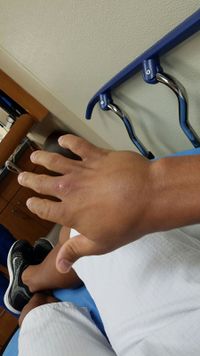Hand and Wrist Sports Injuries
This article or area is currently under construction and may only be partially complete. Please come back soon to see the finished work! (15/03/2020)
Original Editor - Your name will be added here if you created the original content for this page.
Top Contributors - Lucinda hampton, Chrysolite Jyothi Kommu, Temitope Olowoyeye, Khloud Shreif, Tony Lowe, Kim Jackson, Vidya Acharya and Wanda van Niekerk
Introduction[edit | edit source]
With so many bones, ligaments, tendons, and joints keeping hands and wrists working, there is ample opportunity for injury. In fact, injuries to the hand and wrists are some of the most common ailments facing athletes.
- Approximately 25 % of all sports-related injuries involve the hand or wrist
- If managed properly most athletes can expect their injury to heal without any significant long-term disability.[1]
- Incidence is growing not only due to the competitive level of high school and collegiate athletes but also due to the activity level of the general population
- Hand and wrist injuries are common and can have a significant impact especially if initially disregarded with a resultant delay to treatment[2].
Common Sports Related Injuries.[edit | edit source]
Knowledge of common sports-related injuries and therapeutic strategies can help the physiotherapist effectively treat the athlete considering their sports, position, and timing during season.
Radial-sided wrist injuries[edit | edit source]
Radial-sided tendinopathies:
- de Quervain’s tenosynovitis;
- Intersection syndrome, also called Oarsman’s wrist, is caused by friction at the crossing of the tendons of the first extensor compartment as they pass over the tendons of the second extensor compartment (extensor carpi radialis longus and brevis) or a stenosing tenosynovitis within the second extensor compartment itself. Pain is elicited with extension and radial deviation approximately 4–8 cm proximal to the radial styloid. Without careful attention to the location of pain, this can be misdiagnosed as de Quervain’s tenosynovitis.;
- Tendonitis of the flexor carpi radialis is due to repetitive wrist flexion or acute overstretching of the wrist as can be seen in volleyball or water polo. Pain develops from tendon thickening as it runs in its tunnel adjacent to the carpal tunnel. Pain typically courses from the radial palmar wrist crease towards the base of the second metacarpal made worse by resisted wrist flexion.
Ulnar-sided wrist injuries[edit | edit source]
Triangular fibrocartilage complex tears
Hook of the hamate fractures
Hand/finger injuries[edit | edit source]
Thumb ulnar collateral ligament tears
Metacarpal/phalangeal fractures
Metacarpal fractures
Phalangeal fractures
Central slip ruptures
Pulley ruptures
Jersey finger
Mallet finger
Sub Heading 3[edit | edit source]
Conclusion[edit | edit source]
<section> Hand and wrist injuries in athletics are common and can have a significant impact in multiple areas. Knowledge of these entities and special consideration for the athlete can help the team physician effectively treat these players and help them achieve their goals. </section><section>
Abbreviations[edit | edit source]
</section>
- bulleted list
- x
or
- numbered list
- x
References[edit | edit source]
- ↑ American society for sports medicine Hand and Wrist Injuries EXPERT CONSULTANT: Dan Matth Available from:https://www.sportsmed.org/aossmimis/STOP/Downloads/SportsTips/HandandWristInjuries.pdf (last accessed 15.3.2020)
- ↑ Avery DM, Rodner CM, Edgar CM. Sports-related wrist and hand injuries: a review. Journal of orthopaedic surgery and research. 2016 Dec 1;11(1):99. Available from:https://josr-online.biomedcentral.com/articles/10.1186/s13018-016-0432-8 (last accessed 15.3.2020)







